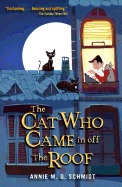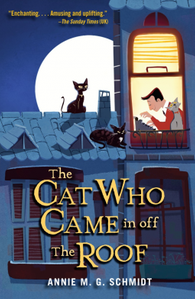
 Tibble, a shy newspaperman, prefers cats to people. He is an excellent writer for the Killenthorn Courier, but his editor calls him into his office one day. "Your articles are always about cats," he says.
Tibble, a shy newspaperman, prefers cats to people. He is an excellent writer for the Killenthorn Courier, but his editor calls him into his office one day. "Your articles are always about cats," he says.
It's true. Tibble is a "real cat lover" and knows all the local cats. He points out to the editor that there's already plenty of news in the newspaper. "I thought people would like to read about cats and leaves for a change," says Tibble. His editor firmly disagrees and gives him one last chance to write an article containing real news, and he wants it by morning.
The discouraged reporter heads out into the city looking for something interesting to cover until he's so tired he sits down on a bench in Green Square. Suddenly, a big German shepherd, barking furiously, goes racing after--what? A cat? A stork? The dog chases it into a tall elm tree. Tibble and his accidental benchmate, Mr. Smith, look up into the tree and see "A leg. A leg in a stylish stocking with a shiny, high-heeled shoe on the foot." " 'Heavens,' " said Mr. Smith. 'It's a lady.' " Tibble helps the frightened young woman down from the tree--she is "tremendously agile"--and wonders whether this outlandish scenario is perhaps newsworthy, but he feels too shy to ask her any questions.
So begins The Cat Who Came in off the Roof, originally published in the Netherlands in 1970 and written by the late Annie M. G. Schmidt, recipient of the 1989 Hans Christian Andersen Award. The young lady chased by a dog up a tree is named Minou, and the reason she seems so very "cattish" is that she used to be a cat, until she ate out of a mysterious rubbish bin at the Institute for Biochemical Research and turned into a human. "Turned into a human! What a horrific punishment," says Minou's feline Aunt Sooty. It's a difficult transition for Minou. "It's all so half and half," she tells the Tatter Cat, "a stray who swiped her meat scraps from all layers of society." Minou looks 100% red-haired, green-eyed human on the outside, but she still feels "one hundred percent cat" inside, and she still purrs and hisses and rubs up against people. (The rubbing-up part of Minou's felinity makes poor Tibble particularly uncomfortable.)
Tibble takes Minou in, allows her to sleep in a box on the floor of his attic apartment, and tells any nosy people that she is his secretary. In return, Minou uses her abundant cat contacts to become an excellent source for all the city's breaking news, much to the delight of Tibble's editor. Not only does Minou make herself invaluable in the "Cat Press Agency," she also purrs her way into the gentle, nervous Tibble's heart. The genuinely funny story of how these two shy beings make room for each other in their lives is as irresistible as kittens. Schmidt raises questions about what it is to be human, what it is to be a cat, what it is to be something in between, and what it means to accept someone for who she is, even if she is "shilly-shallying" herself. --Karin Snelson, children's and YA editor, Shelf Awareness
Shelf Talker: In this charming Dutch classic, the life of a newspaperman named Tibble is changed forever when he encounters a strange young lady who used to be a cat.

